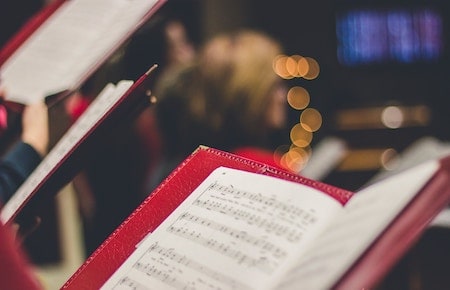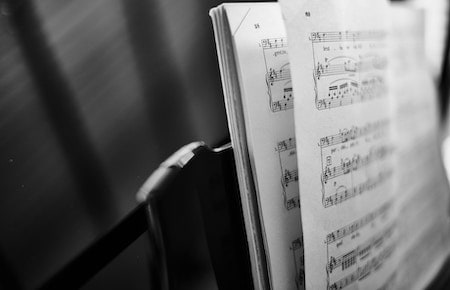
A bounding, joyous SATB chorus, movement 26 of Handel's Messiah. Ends with a slow quiet coda. Orchestral direction follows the London Philharmonic recording.
F

A full-blown fugue for SATB chorus, in grand Renaissance style. Handel doubles all the choral parts clearly in the orchestra, making this an easy fugue to sing. Movement 25 of the Messiah.
Fm

A powerful, strong SATB choral work, movement 24 of Handel's Messiah. In only 19 measures, the choir sings powerful unison rhythms, soft contrapuntal entrances, and a forceful antiphonal ending. Beautiful and recognizable.
Fm

This quiet alto aria about Christ's generosity towards his abusers is the B section of movement 23 of the Messiah. It was recorded separately so that it can be used alone, as a short and simple aria, or as a bridge to "He Was Despised" (Spiritrax 1208) as per Handel's original instructions.
Cm

A slow, moving aria for alto, Movement 23 of Handel's Messiah, describing Christ's sorrows. Strings gently weep in the accompaniment. As the A section is over five minutes in length, Handel's instructions to continue with a bridge and then repeat the A section in its entirety are rarely followed. This recording ends, like most, at the end of the A section; the bridge is available separately as Spiritrax 1209, "He Gave His Back to the Smiters".
Eb

This slow minor-key SATB chorus is Movement 22 of Handel's Messiah, opening the second part. Beautiful and dramatic canonic entrances, with all the choral parts clearly mirrored in the orchestra.
Gm

This grand and peaceful SATB chorus is movement 21 of Handel's Messiah. The last movement in Part 1, it is usually the last song before intermission in performances of the full work. Gentle and easy to sing with a triumphant ending, with a text simple enough for anyone to understand.
Bb

Movement 20 in Handel's Messiah is a gentle, flowing double aria for alto and soprano. The text describes how Jesus will protect his people. The alto sings the first half in F, and then the soprano takes over in Bb for the second half. Simple and beautiful. Could be done by one singer with a large range, but really perfect to feature two.
F

Movement 19 of Handel's Messiah is a brief alto recitative, reciting the miracles that will occur when Jesus is born. Accompanied by bass, cello, and harpsichord.
Am

Movement 18 of Handel's Messiah is a dramatic and involved aria for soprano. A fast major-key beginning and end require virtuosic singing, and the slow minor-key middle section gives the singer lots of room to be expressive. Orchestral direction reflects the London Philharmonic Orchestra recording.
Bb

This well-known soprano aria is movement 52 of the Messiah. Follows Handel's original orchestral score. A beautiful number for solo performance.
Gm

Movement 17 from Handel's Messiah, this is a joyous SATB chorus, complete with trumpets, woodwinds, strings, and harpsichord. The text of "peace on Earth, goodwill towards men" is perfect for Christmas. Orchestral direction reflects the London Philharmonic Orchestra recording. Includes mvmnt. 16 (an 8-measure soprano recitative) as an introduction.
D

This soprano recitative comprises movements 14 and 15 of Handel's Messiah. It tells of the angel of God appearing to the shepherds. Very slow and rubato, with timings carefully matched to the London Philharmonic Orchestra recording.
C

The twelfth movement in Handel's Messiah is a joyous SATB chorus celebrating Christ's birth. The vocal parts alternate between quiet sections of imitative polyphony and strong sections of heroic union fanfares. All parts match Handel's original score, and orchestral direction is similar to the well-known recordings by the London Symphony Orchestra.
G

Movement thirteen in Handel's Messiah is the only purely instrumental movement, without any singing at all. It's useful as an interlude, contemplative moment, or during an intermission. The title "Pifa" suggests shepherds' music played traditionally at Christmas by the Italian "pifferare" (pipers or shepherds).
C